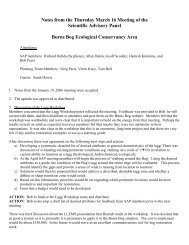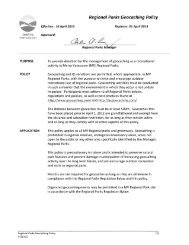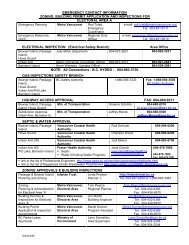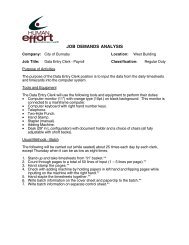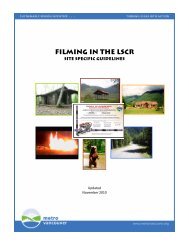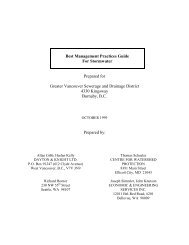Chlorine Monitoring and Dechlorination Techniques Handbook
Chlorine Monitoring and Dechlorination Techniques Handbook
Chlorine Monitoring and Dechlorination Techniques Handbook
You also want an ePaper? Increase the reach of your titles
YUMPU automatically turns print PDFs into web optimized ePapers that Google loves.
<strong>Chlorine</strong> <strong>Monitoring</strong> <strong>and</strong> Dechlorinating <strong>Techniques</strong> H<strong>and</strong>book<br />
Be sure that the reagent expiry date is clearly marked <strong>and</strong> that staff check the expiry date<br />
before using each reagent pouch.<br />
2.2.3 Spectrophotometers<br />
There are a number of field spectrophotometers that can be used for measurement of residual<br />
chlorine levels. One model is a pocket-sized instrument that tests for free <strong>and</strong> total residual<br />
chlorine over the operating range of 0 to 3.9 ppm. The meter reads in 0.01 ppm increments<br />
with an accuracy of 0.05 ppm. The meter itself has dimensions of 4.5 x 12 x 8.9 cm. The<br />
reagent used in these types of instruments is typically DPD, as described above.<br />
The cost of the pocket device is approximately $300. The GVWD staff have had some<br />
difficulties with using this equipment in the field due to weather conditions <strong>and</strong> prefer the<br />
colour comparator kit which can be kept in the service truck.<br />
2.2.4 Laboratory Analysis<br />
Laboratory analysis for total residual chlorine in water is not recommended due to the very<br />
short storage time that a sample can remain stable, <strong>and</strong> the relatively long turnaround time<br />
for results. <strong>Chlorine</strong> dissipates from a water sample very quickly as a result of exposure to<br />
light, increased temperature, <strong>and</strong> agitation. According to the US EPA st<strong>and</strong>ard laboratory<br />
techniques for residual chlorine analysis Method 4500-Cl, samples to be analysed for<br />
residual chlorine should not be stored at all, but analysed immediately.<br />
The US EPA St<strong>and</strong>ard Method 4500-Cl outlines different methods to detect residual<br />
chlorine, including:<br />
the Iodometric Method;<br />
the Amperometric Titration Method;<br />
the Low-Level Amperometric Titration Method<br />
the DPD Colorimetric Method;<br />
the Syringaldazine (FACTS) Method; <strong>and</strong><br />
the Iodometric Electrode Technique.<br />
The advantage of these methods is that the detection limits are as low as 0.010 mg/L (ppm<br />
or 10 g/L (ppb), depending on the sophistication of the equipment.<br />
It is recommended that sampling for total residual chlorine be<br />
completed in the field using a field testing kit to obtain the<br />
best results. In special cases, lower detection limit methods<br />
could be used by setting titration equipment in the field.<br />
Page 8




